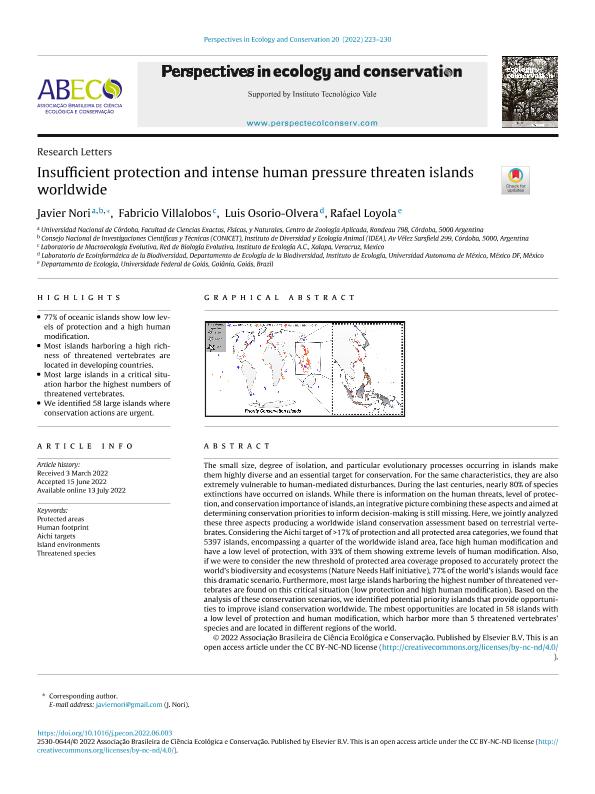Mostrar el registro sencillo del ítem
dc.contributor.author
Nori, Javier

dc.contributor.author
Villalobos Camacho, Crisoforo Fabricio

dc.contributor.author
Osorio Olvera, Luis Alfredo

dc.contributor.author
Loyola, Rafael

dc.date.available
2023-07-14T11:30:51Z
dc.date.issued
2022-07-13
dc.identifier.citation
Nori, Javier; Villalobos Camacho, Crisoforo Fabricio; Osorio Olvera, Luis Alfredo; Loyola, Rafael; Insufficient protection and intense human pressure threaten islands worldwide; Elsevier; Perspectives in Ecology and Conservation; 20; 3; 13-7-2022; 223-230
dc.identifier.issn
2530-0644
dc.identifier.uri
http://hdl.handle.net/11336/203917
dc.description.abstract
The small size, degree of isolation, and particular evolutionary processes occurring in islands make them highly diverse and an essential target for conservation. For the same characteristics, they are also extremely vulnerable to human-mediated disturbances. During the last centuries, nearly 80% of species extinctions have occurred on islands. While there is information on the human threats, level of protection, and conservation importance of islands, an integrative picture combining these aspects and aimed at determining conservation priorities to inform decision-making is still missing. Here, we jointly analyzed these three aspects producing a worldwide island conservation assessment based on terrestrial vertebrates. Considering the Aichi target of >17% of protection and all protected area categories, we found that 5397 islands, encompassing a quarter of the worldwide island area, face high human modification and have a low level of protection, with 33% of them showing extreme levels of human modification. Also, if we were to consider the new threshold of protected area coverage proposed to accurately protect the world's biodiversity and ecosystems (Nature Needs Half initiative), 77% of the world's islands would face this dramatic scenario. Furthermore, most large islands harboring the highest number of threatened vertebrates are found on this critical situation (low protection and high human modification). Based on the analysis of these conservation scenarios, we identified potential priority islands that provide opportunities to improve island conservation worldwide. The mbest opportunities are located in 58 islands with a low level of protection and human modification, which harbor more than 5 threatened vertebrates’ species and are located in different regions of the world.
dc.format
application/pdf
dc.language.iso
eng
dc.publisher
Elsevier

dc.rights
info:eu-repo/semantics/openAccess
dc.rights.uri
https://creativecommons.org/licenses/by-nc-nd/2.5/ar/
dc.subject
AICHI TARGETS
dc.subject
HUMAN FOOTPRINT
dc.subject
ISLAND ENVIRONMENTS
dc.subject
PROTECTED AREAS
dc.subject
THREATENED SPECIES
dc.subject.classification
Conservación de la Biodiversidad

dc.subject.classification
Ciencias Biológicas

dc.subject.classification
CIENCIAS NATURALES Y EXACTAS

dc.title
Insufficient protection and intense human pressure threaten islands worldwide
dc.type
info:eu-repo/semantics/article
dc.type
info:ar-repo/semantics/artículo
dc.type
info:eu-repo/semantics/publishedVersion
dc.date.updated
2023-07-07T19:02:39Z
dc.journal.volume
20
dc.journal.number
3
dc.journal.pagination
223-230
dc.journal.pais
Países Bajos

dc.journal.ciudad
Amsterdam
dc.description.fil
Fil: Nori, Javier. Consejo Nacional de Investigaciones Científicas y Técnicas. Centro Científico Tecnológico Conicet - Córdoba. Instituto de Diversidad y Ecología Animal. Universidad Nacional de Córdoba. Facultad de Ciencias Exactas Físicas y Naturales. Instituto de Diversidad y Ecología Animal; Argentina
dc.description.fil
Fil: Villalobos Camacho, Crisoforo Fabricio. Consejo Nacional de Ciencia y Tecnología. Instituto de Ecología; México
dc.description.fil
Fil: Osorio Olvera, Luis Alfredo. Universidad Nacional Autónoma de México; México
dc.description.fil
Fil: Loyola, Rafael. Universidade Federal de Goiás; Brasil
dc.journal.title
Perspectives in Ecology and Conservation
dc.relation.alternativeid
info:eu-repo/semantics/altIdentifier/url/https://www.sciencedirect.com/science/article/pii/S2530064422000396
dc.relation.alternativeid
info:eu-repo/semantics/altIdentifier/doi/https://doi.org/10.1016/j.pecon.2022.06.003
Archivos asociados
